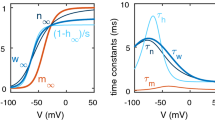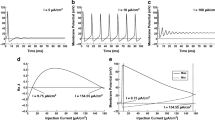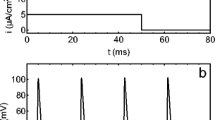Abstract
It is widely believed, following the work of Connor and Stevens (1971,J. Physiol. Lond. 214, 31–53) that the ability to fire action potentials over a wide frequency range, especially down to very low rates, is due to the transient, potassium A-current (I A). Using a reduction of the classical Hodgkin-Huxley model, we study the effects ofI A on steady firing rate, especially in the near-threshold regime for the onset of firing. A minimum firing rate of zero corresponds to a homoclinic bifurcation of periodic solutions at a critical level of stimulating current. It requires that the membrane's steady-state current-voltage relation be N-shaped rather than monotonic. For experimentally based genericI A parameters, the model does not fire at arbitrarily low rates, although it can for the more atypicalI A parameters given by Connor and Stevens for the crab axon. When theI A inactivation rate is slow, we find that the transient potassium current can mediate more complex firing patterns, such as periodic bursting in some parameter regimes. The number of spikes per burst increases asg A decreases and as inactivation rate decreases. We also study howI A affects properties of transient voltage responses, such as threshold and firing latency for anodal break excitation. We provide mathematical explanations for several of these dynamic behaviors using bifurcation theory and averaging methods.
Similar content being viewed by others
References
Awiszus, F. 1992. Reduction of a Hodgkin-Huxley-type model for a mammalian neuron at body temperature.Biol. Cybern. 67, 427–432.
Baer, S. M., T. Erneux and J. Rinzel. 1989. The slow passage through a Hopf-bifurcation: delay, memory effects and resonance.SIAM J. Appl. Math. 49, 55–71.
Bargas, J., E. Galarraga and J. Aceves. 1989. An early outward conductance modulates the firing latency and frequency of neostriatal neurons of the rat brain.Exp. Brain Res. 75, 146–156.
Bogdanov, R. I. 1975. Versal deformations of a singular point on the plane in the case of zero eigenvalues.Funct. Anal. Appl. 9, 144–145.
Buchholtz, F., J. Golowasch, I. R. Epstein and E. Marder. 1992. Mathematical model of an identified stomatiogastric ganglion neuron.J. Neurophysiol. 67, 332–340.
Byrne, J. H. 1980. Quantitative aspects of ionic conductance mechanisms of contributing to firing patterns of motor cells mediating inking behavior inaplysia california.J. Neurophysiol. 43, 651–668.
Connor, J. A. and C. F. Stevens. 1971. Prediction of repetitive firing behavior from voltage-clamp data on an isolated neurone soma.J. Physiol. Lond. 214, 31–53.
Connor, J. A., D. Walter and R. McKown. 1977. Neural repetitive firing: modifications of the Hodgkin-Huxley axon suggested by experimental results from crustacean axons.Biophys. J. 18, 81–102.
Dekin, M. S. and P. A. Getting. 1987. In vitro characterization of neurons in the ventral part of the nucleus tractus solitarius. III. ionic basis for repetitive firing patterns.J. Neurophysiol. 58, 215–229.
Dodge, F. A. 1972. On the transduction of visual, mechanical, and chemical stimuli.Int. J. Neurosc. 3, 5–14.
Doedel, E. J. 1981. AUTO: A program for the automatic bifurcation analysis of autonomous systems.Congr. Numer. 30, 265–284.
FitzHugh, R. 1976. Anodal excitation in the Hodgkin-Huxley nerve model.Biophy. J. 16, 209–226.
Gerber, B. and E. Jakobsson. 1993. The functional significance of the A-current.Biol. Cybernetics. 70, 109–114.
Getting, P. 1983. Mechanisms of pattern generating underlying swimming inTritonia. III. intrinsic and synaptic mechanisms for delayed excitation.J. Neurophysiol. 49, 1036–1050.
Golowasch, J. and E. Marder. 1992. Ionic currents of the lateral pyloric neuron of the stomatogastric ganglion of the crab.J. Neurophysiol. 66, 318–331.
Graubard, K. and D. K. Hartline. 1991. Voltage clamp analysis of intact stomatogastric neurons.Brain Res. 557, 241–254.
Guckenheimer, J., S. Gueron and R. M. Harris-Warrick. 1992. Mapping the dynamics of a bursting neuron.Phil. Trans. Roy. Soc. Lond. Ser. B 341, 345–359.
Hassard, B. D. and L. J. Shiau. 1991. Degenerate Hopf bifurcation and isolated periodic solutions of the Hodgkin-Huxley model with varying sodium ion concentration.J. Theor. Biol. 148, 157–173.
Hodgkin, A. L. and A. F. Huxley. 1952. A quantitative description of membrane current and its application to conduction in nerve.J. Physiol. Lond. 117, 500–544.
Huguenard, J. R. and D. A. McCormick. 1992. Simulation of the currents involved in rhythmic oscillations in thalamic relay neurons.J. Neurophysiol. 68, 1373–1383.
Kaczmarek, L. K. and F. Strumwasser. 1984. A voltage-clamp analysis of currents underlying cyclic amp-induced membrane modulation in isolated peptidergic neurons ofAplysia.J. Neurophysiol. 52, 340–349.
Kernell, D. and H. Sjoholm. 1973. Repetitive impulse firing: comparison between neurone models based on voltage clamp equations and spinal motoneurones.Acta Physiol. Scand. 87, 40–56.
Labouriau, I. S. 1989. Degenerate Hopf bifurcation and nerve impulse. Part II.SIAM J. Math. Anal. 20, 1–12.
McCormick, D. A. 1991. Functional properties of a slowly inactivating potassium current in guinea pig dorsal lateral geniculate relay neurons.J. Neurophysiol. 66, 1176–1189.
Neher, E. 1971. Two fast transient current components during voltage clamp on snail neurons.J. Gen. Physiol. 58, 36–53.
Rinzel, J. 1978. On repetitive activity in nerve.Federation Proc. 37, 2793–2802.
Rinzel, J. 1985. Excitation dynamics: insights from simplified membrane models.Federation Proc. 44, 2944–2946.
Rinzel J. 1987. A formal classification of bursting mechanisms in excitable systems. InMathematical Topics in Population Biology Morphogensis and Neurosciences. Lecture Notes in Biomathematics T. E. Yamaguti and M. Yamaguti (Eds), Vol. 71, pp. 267–281. New York: Springer-Verlag.
Rinzel, J. and G. B. Ermentrout. 1989. Analysis of neural excitability and oscillations. InMethods in Neuronal Modeling: From Synapses to Networks C. Koch and I. Seger (Eds), pp. 135–169. Cambridge MA: MIT Press.
Rogawski, M. A. 1985. The A-current: how ubiquitous a feature of excitable cells is it?Trends Neurosci. 8, 214–219.
Rose, R. M. and J. L. Hindmarsh. 1985. A model of a thalamic neuron.Proc. Roy. Soc. Lond. Ser. B 225, 161–193.
Shapiro, B. I. and F. K. Lenherr. 1972. Increased modulation and linearity to response to constant current stimulus.Biophys. J. 12, 1145–1158.
Storm, J. F. 1988. Temporal integration by a slowly inactivating K+ current in hippocampal neurons.Nature 336, 379–381.
Surmeier, D. J., J. Bargas and S. T. Kitai. 1988. Voltage-clamp analysis of a transient potassium current in rat neostriatal neurons.Brain Res. 473, 187–192.
Surmeier, D. J., J. Bargus, and S. T. Kitai. 1989. Two types of A-current differing in voltage-dependence are expressed by neurons of the rat neostriatum.Neurosci. Lett. 103, 331–337.
Takens, F. 1974. Singularities of vector fields.Publ. Math. IHES 43, 47–100.
Thompson, S. 1977. Three pharmacologically distinct potassium channels in molluscan neurones.J. Physiol. 265, 465–488.
Thompson, S. 1982. Aminopyridine block of transient potassium current.J. Gen. Physiol. 80, 1–18.
Wang, X. J. 1993. Ionic basis for intrinsic 40 Hz neuronal oscillations.NeuroReport 5, 221–224.
Williams, J. T., R. A. North, S. A. Shefner, S. Nishi and T. M. Egan. 1984. Membrane properties of rat locus coeruleus neurons.Neuroscience 13, 137–156.
Author information
Authors and Affiliations
Rights and permissions
About this article
Cite this article
Rush, M.E., Rinzel, J. The potassium A-current, low firing rates and rebound excitation in Hodgkin-Huxley models. Bltn Mathcal Biology 57, 899–929 (1995). https://doi.org/10.1007/BF02458299
Received:
Accepted:
Published:
Issue Date:
DOI: https://doi.org/10.1007/BF02458299




